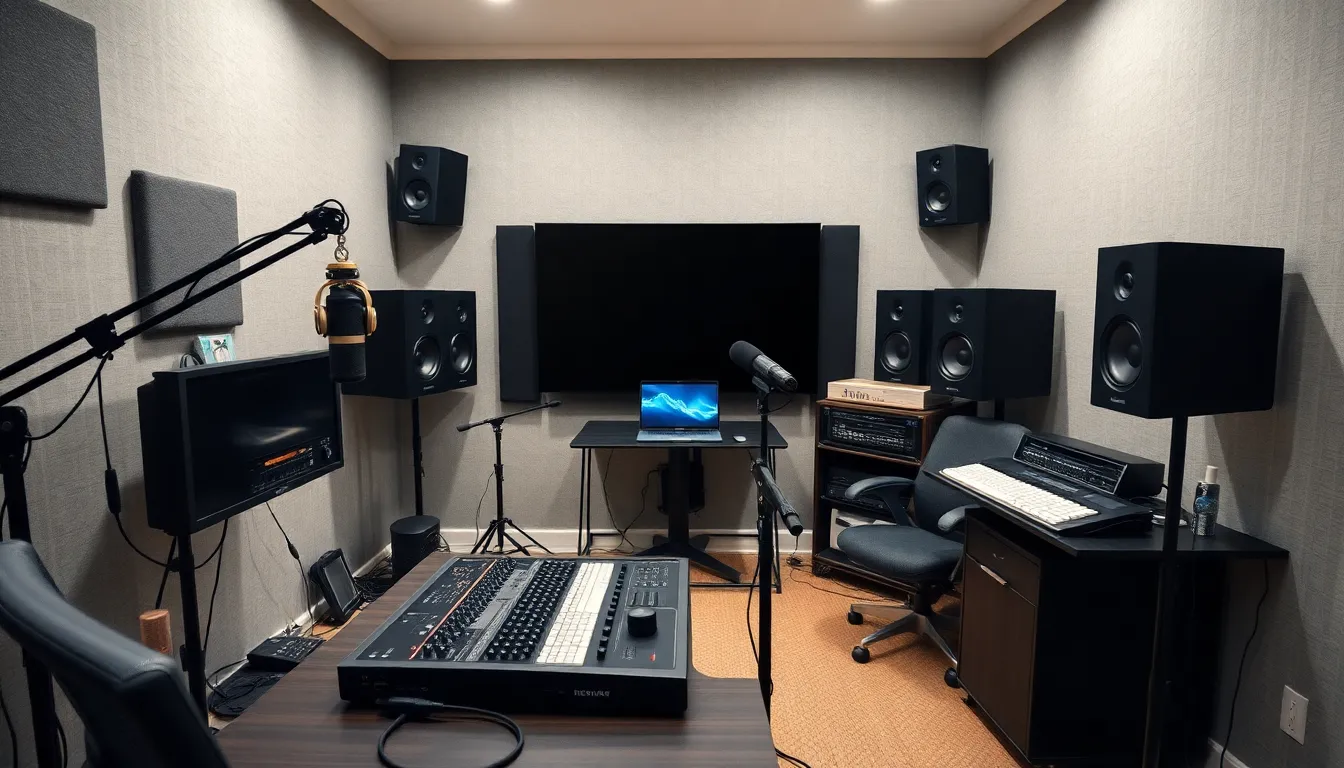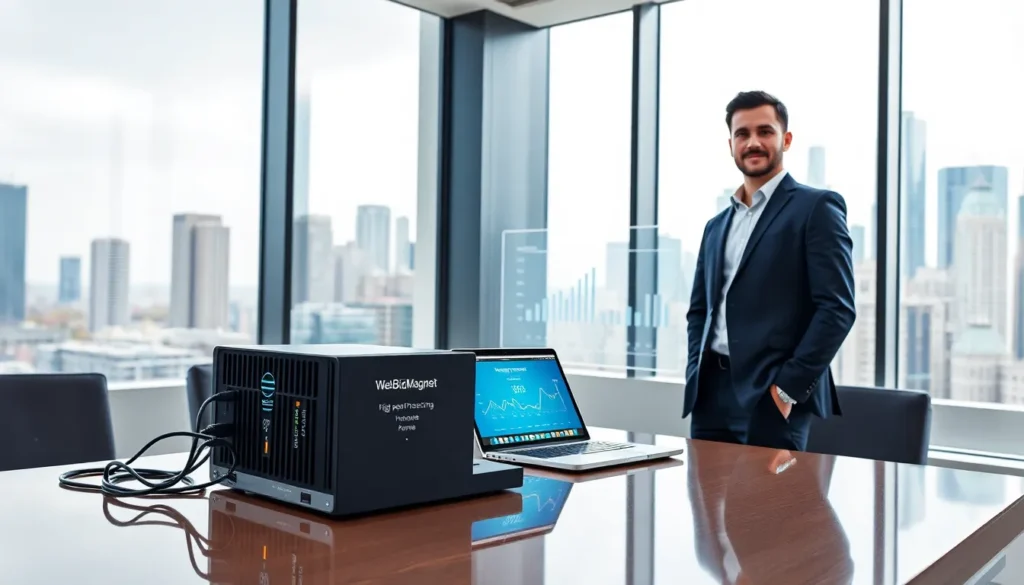Imagine transforming that spare room or closet into a creative haven where musical magic happens. A home recording studio isn’t just for rock stars or tech wizards; it’s for anyone with a passion for sound. Whether it’s laying down tracks for a catchy jingle or recording your grand debut album, the possibilities are endless.
Table of Contents
ToggleOverview of Home Recording Studios
Home recording studios offer unique opportunities for creativity and expression. Anyone, regardless of experience level, can transform a space into a recording setup. This trend continues to grow as technology becomes more accessible and affordable.
Rooms designated for recording typically require specific equipment. Essential items include microphones, audio interfaces, and headphones. Proper acoustics also enhance the quality of recordings, making sound treatment an important consideration.
Budget influences studio setup considerably. An entry-level studio can start with basic gear costing around $500. More advanced setups can exceed thousands of dollars depending on the quality and quantity of equipment chosen.
Recording facilities often involve various software choices. Digital Audio Workstations (DAWs) like Ableton Live, Pro Tools, or GarageBand allow users to edit and mix tracks efficiently. Familiarity with these tools significantly enhances the recording process.
Additionally, home studios serve multiple purposes. Musicians create full albums, voice-over artists record scripts, and podcasters produce content. This flexibility satisfies a wide range of creative needs.
Ultimately, a home recording studio represents a personal sanctuary for artistic endeavors. Investing in the right equipment and space fosters an environment conducive to creativity and productivity. As more individuals embrace this concept, the boundaries of music creation continue to expand.
Essential Equipment for a Home Recording Studio

Every home recording studio requires specific equipment to achieve optimal sound quality and versatility. The following items serve as a foundation for building a successful studio.
Audio Interface
An audio interface connects microphones and instruments to a computer, allowing for high-quality audio capture. Many interfaces provide multiple inputs for recording various instruments simultaneously, enhancing creativity. A popular model includes the Focusrite Scarlett, praised for its affordability and sound quality. Look for interfaces that offer low latency to ensure real-time monitoring during recording sessions. It’s essential to consider compatibility with DAWs, ensuring seamless integration into the existing workflow.
Microphones
Microphones come in various types, with condenser and dynamic models being the most common for home studios. Condenser microphones excel at capturing vocals and acoustic instruments, while dynamic microphones are ideal for high-volume sources like electric guitars and drums. Models such as the Shure SM58 and Audio-Technica AT2020 cater to different recording needs. Investing in a good quality microphone significantly influences the overall sound of recordings. Additionally, using pop filters can reduce unwanted plosive sounds, improving vocal clarity.
Monitors and Headphones
Studio monitors and headphones are crucial for accurate sound representation during mixing and mastering. Flat-response monitors minimize colorations, enabling a clearer judgment of mixes. Brands like KRK and Yamaha offer quality options for various budgets. Closed-back headphones provide effective noise isolation, making them ideal for tracking and monitoring recordings. Selecting the right combination of monitors and headphones ensures that recordings translate well across different playback systems, enhancing the final output quality.
Setting Up Your Home Recording Studio
Creating an efficient home recording studio involves thoughtful planning and execution. Attention to detail significantly impacts sound quality and usability.
Acoustic Treatment
Acoustic treatment enhances sound clarity in a home recording studio. Soundproofing materials like foam panels, bass traps, and diffusers minimize unwanted noise. Placing foam panels on walls absorbs reflections, while bass traps in corners control low frequencies. Monitor placement benefits from optimal positioning, avoiding direct reflection from walls. Choosing thick rugs or carpets also reduces sound reflections on hard surfaces. Prioritizing acoustic treatment ensures a more professional recording environment.
Layout and Design
Layout and design play crucial roles in studio functionality. Arranging equipment within easy reach streamlines workflow. Positioning studio monitors at ear level and forming an equilateral triangle creates an optimal listening environment. The desk should accommodate a computer, audio interface, and other essential tools conveniently. Incorporating good lighting fosters a creative atmosphere. Using cable management solutions keeps the space organized and clutter-free. A well-designed layout ultimately encourages smooth creative processes and enhances productivity.
Software for Home Recording
Home recording studios rely heavily on software to facilitate high-quality music production. The right tools enhance creativity and streamline workflows for musicians, podcasters, and voice-over artists.
Digital Audio Workstations (DAWs)
Digital Audio Workstations serve as the backbone of any home recording setup. DAWs like Ableton Live, Pro Tools, and GarageBand offer intuitive interfaces for recording and editing audio. Features such as multi-track recording allow users to layer instruments and vocals seamlessly. With built-in virtual instruments and effects, DAWs cater to diverse styles and preferences. It’s important to choose a DAW that fits specific needs and technical expertise. Whether a beginner or seasoned professional, the right DAW can make a significant impact on the recording process.
Plug-Ins and Effects
Plug-ins and effects enhance DAW capabilities, adding depth to recordings. Audio plug-ins range from virtual instruments to effects processors like equalizers and compressors. These tools shape sound quality and improve mix clarity. Popular plug-ins include iZotope Ozone for mastering and Waves for various effects. By incorporating these elements, home studios achieve professional-grade production. Users can customize sound and create unique audio signatures. Exploring different plug-ins enables artists to find the right fit for their projects.
Recording Techniques and Tips
Achieving high-quality recordings in a home studio requires attention to detail. Focus on microphone placement since small adjustments can significantly impact sound. Experimenting with different positions helps to uncover the sweet spot for vocals or instruments.
Utilizing recording techniques like double tracking can add depth and richness to recordings. Artists often layer multiple takes of their vocals or instruments for a fuller sound. This method proves effective in creating a more polished production.
Using proper gain staging during recording avoids distortion and maintains clarity. By ensuring levels remain optimal throughout the recording process, quality remains consistent. Monitoring sound levels through studio monitors or headphones proves essential for maintaining fidelity.
Choosing the right recording environment affects sound quality. Ideal spaces are quiet and free from external noise. Crafting a dedicated recording area with soundproofing materials further enhances the acoustic experience.
Considering the use of software tools can streamline the recording process. Many DAWs feature built-in tools for pitch correction, reverb, and compression. These tools enable artists to enhance their recordings with minimal effort.
Employing effective editing techniques post-recording ensures a polished final product. Clean up excess noise and unwanted sounds using digital audio editing features. This process helps to refine recordings, making them suitable for professional release.
Experimenting with different effects can add character to a track. Reverb, delay, and equalization are commonly used to shape sound further. These effects offer creative opportunities while emphasizing specific elements in a mix.
Fostering a comfortable environment enhances creativity. Artists tend to perform better in spaces that reflect their personality. Personal touches, like artwork or ambient lighting, contribute to a relaxed atmosphere.
Creating a home recording studio opens doors to endless creative possibilities. With accessible technology and affordable equipment, anyone can transform a space into a personal sound sanctuary. From capturing music to producing podcasts, the opportunities are vast and varied.
By investing in essential gear and focusing on acoustics, individuals can significantly enhance their recording quality. The right software tools further empower creators to refine their sound and produce professional-grade content. Ultimately, a home recording studio not only fosters artistic expression but also provides a unique environment that encourages growth and creativity. Embracing this journey can lead to remarkable achievements in the world of music and audio production.









